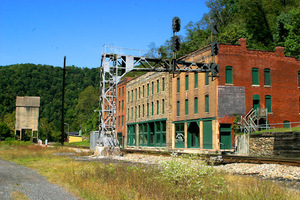 | Back to e-WV
| Back to e-WV
 The West Virginia Encyclopedia
The West Virginia Encyclopedia
 | Back to e-WV
| Back to e-WV
 The West Virginia Encyclopedia
The West Virginia Encyclopedia

West Virginia’s best-known boom town straddled the Chesapeake & Ohio (C&O) Railway deep in the New River Gorge. Thurmond meant excitement, danger, and pleasures of the hell-raising variety to generations of miners, railroaders, and traveling men, and the Fayette County community is still remembered that way by many today.
Thurmond was founded by Capt. W. D. Thurmond in the 1880s, following local completion of the C&O in 1873. Thurmond was a railroad town, occupying a strategic site where important feeder lines came down to the main railroad from the burgeoning New River coalfield. Thanks to coal, Thurmond became a major revenue producer for the C&O, originating more freight tonnage than did Cincinnati or Richmond. The railroad located a major rail yard, water and coaling facilities for steam locomotives, and maintenance shops at Thurmond. Goods poured in while the coal rolled out, and during its heyday Thurmond was busier than the nearby county seat towns of Fayetteville and Beckley. Banks, wholesale grocers, the telephone and telegraph companies, and other key operations located themselves in Thurmond.
The bustling community attracted less reputable business, as well. But the brothels and saloons which gave Thurmond its bad name were located outside the city limits, mostly across the New River in the ‘‘Ballyhack’’ neighborhood. Captain Thurmond, who owned almost all Thurmond’s real estate during his lifetime, was a strict Baptist who forebade riotous living within his jurisdiction.
Nonetheless, the Captain’s town developed the worst sort of reputation. Thurmond was characterized as the Dodge City of the East, ‘‘hell with a river through it,’’ where miners and their money were parted with bloody corpses the occasional byproduct. A poker game ran for 14 years at the Dunglen, before an arsonist torched the grand southside hotel. Marshal Harrison Ash, himself perhaps acquainted with both sides of the law, broke heads of individual offenders but made little headway against the overall problem.
Thurmond grew to 315 residents by 1910, the year its founder died, and peaked at 462 in 1930. Its decline began with the spread of highways through the region; historian Kyle McCormick said the rail town died of ‘‘good roads and a bad name.’’ A series of fires reduced Thurmond’s size. But the town prospered in a modest fashion through the end of steam railroading, which came in the 1950s on the C&O.
Today, Thurmond is mostly a ghost town. The trackside business block remains, however, along with the restored depot and other historic structures, providing picturesque settings for the movie Matewan in 1986. The Thurmond Historic District was added to the National Register of Historic Places in 1984. Thurmond is a major put-in point for whitewater rafters, and the centerpiece of National Park Service efforts to interpret the history of New River Gorge National Park and Preserve.
Read the National Register of Historic Places nomination for Thurmond.
Written by Ken Sullivan
Sullivan, Ken. Thurmond: A New River Community. Oak Hill: Eastern National Park & Monument Association, 1989.